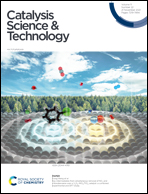Hollow core–shell Co9S8@In2S3 nanotube heterojunctions toward optimized photothermal–photocatalytic performance†
Abstract
Reasonable design of advanced semiconductor photocatalyst structures is an effective strategy for solar-to-chemical energy conversion. Herein, hollow core–shell Co9S8@In2S3 nanotube heterojunctions are designed through two-step hydrothermal and solvothermal strategies. The construction of the heterojunction between Co9S8 and In2S3 enhances the separation efficiency of electron–hole pairs, and the hollow structure of Co9S8@In2S3 improves the scattering and refraction efficiency of incident light and the core–shell structure increases the contact area and provides adequate surface-active sites. In addition, the broad-spectrum absorption enables Co9S8@In2S3 to possess a satisfactory photothermal conversion ability, which can promote the photocatalytic hydrogen production obviously by increasing the system temperature. The maximum photocatalytic H2 productivity achieved on the 20%Co9S8@In2S3 heterojunction is up to 4072.0 μmol g−1 h−1 without any noble metal as co-catalysts, which is 11.7 times higher than that of pristine In2S3 due to the efficient fabrication of the hollow core–shell heterojunction.



 Please wait while we load your content...
Please wait while we load your content...